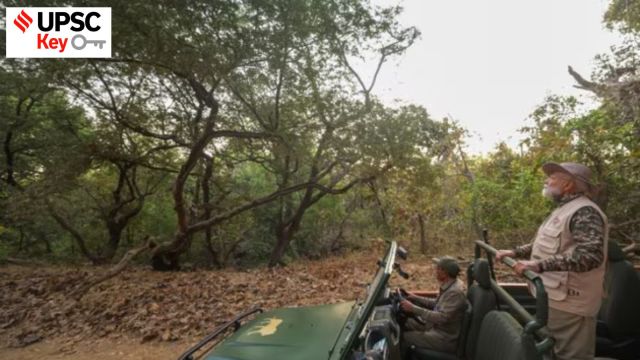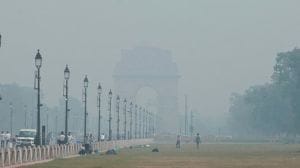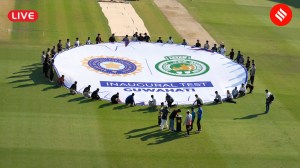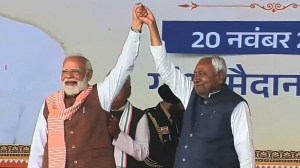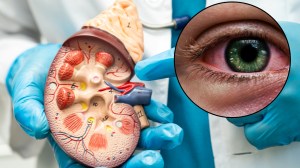
Preliminary Examination: Current events of national importance
Mains Examination: General Studies-II, III: Government policies and interventions, Conservation, environmental pollution and degradation, environmental impact assessment.
What’s the ongoing story: Prime Minister Narendra Modi chaired his first meeting of the National Board for Wildlife (NBWL) at the Gir National Park in Junagadh district on Monday, where he announced plans to expand Project Cheetah to Gandhisagar Sanctuary in Madhya Pradesh and Banni Grasslands in Gujarat.
Key Points to Ponder:
— Read about the National Board for Wildlife.
— Know about the conservation status of gharials, Great Indian Bustards, Asiatic Lions, and Gangetic dolphins.
— What is Project Cheetah?
— What are the challenges faced by wildlife animals?
— What initiatives have been taken by the government for wildlife conservation?
— Map work: Gir National Park
Key Takeaways:
— Modi made a slew of announcements, including on starting the Asiatic Lion population estimation exercise in May, setting up a centre for effective management of human-wildlife conflict, and new conservation initiatives for gharials and Great Indian Bustards. The PM also reviewed the government’s flagship wildlife conservation programmes like Project Lion and Project Cheetah.
Story continues below this ad
— Further, the wildlife board approved Rs 2,900 crore for various conservation works under Project Lion for the next 10 years, and announced a National Great Indian Bustard Conservation Plan as well as a scheme for conservation of tigers outside tiger reserves.
— Under Project Lion, the government aims to increase the range of Asiatic Lions throughout the Saurashtra region. Population estimation of Asiatic Lions is carried out once every five years. The last such exercise was carried out in 2020.
— Under Project Lion, the government aims to increase the range of Asiatic Lions throughout the Saurashtra region. Population estimation of Asiatic Lions is carried out once every five years. The last such exercise was carried out in 2020.
— Modi also laid the foundation stone of the National Referral Centre for Wildlife at Junagadh, which will function as the hub for coordination and governance of various aspects related to wildlife health and disease management.
From “India has 6,327 river dolphins, finds first population survey”
Story continues below this ad
— India has 6,324 Gangetic dolphins across the Ganga and Brahmaputra river basins and three Indus river dolphins in the Beas river basin in Punjab, the country’s first-ever detailed dolphin population survey has found.
— Conducted between 2021 and 2023, the survey covered 8,406 km long stretches of Ganga and Brahmaputra river basins, inclusive of its tributaries, and a 101 km long stretch of the Beas river.
Of the 6,324 Gangetic dolphins, 3,275 were found on the river’s main stem, 2,414 were found in Ganga’s tributaries while 584 were found in Brahmaputra’s main stem. A total of 28 rivers were surveyed by boat for the estimation exercise and 30 river stretches were mapped by road.
— Among range states, 2,397 dolphins were counted in UP, 2,220 in Bihar, 162 in Jharkhand, 95 in Rajasthan and Madhya Pradesh, 815 in West Bengal, 635 in Assam and three in Punjab.
Do You Know:
Story continues below this ad
— Both the Indus and Ganges dolphins have been listed as ‘Endangered’ in the International Union for Conservation of Nature (IUCN) Red List since the 1990s. This classification indicates that the species has “a very high risk of becoming extinct in the wild”. After the launch of Ganga Action Plan in 1985, the government in 1986 included Gangetic dolphins in the First Schedule of the Indian Wildlife (Protection) Act, 1972.
— Lions are classified as ‘Vulnerable‘ on the IUCN Red List and are listed in Schedule I of the Wildlife (Protection) Act, 1972. The species is listed in Appendix II of CITES, while the Asiatic lion subspecies (Panthera leo persica) is listed in Appendix I.
Other Important Articles Covering the same topic:
📍Knowledge nugget of the day: Satellite tagging of a Ganges dolphin
📍Knowledge Nugget | From CITES to Species in news — what you must know on World Wildlife Day 2025 for UPSC Exam?
Previous year UPSC Prelims Question Covering similar theme:
Story continues below this ad
(1) Which one of the following is the national aquatic animal of India? (UPSC CSE2015)
(a) Saltwater crocodile
(b) Olive ridley turtle
(c) Gangetic dolphin
(d) Gharial
EXPRESS NETWORK
Syllabus:
Preliminary Examination: Current events of national and international importance
Mains Examination: General Studies-II: Issues relating to development and management of Social Sector/Services relating to Health, Education, Human Resources.
What’s the ongoing story: The obesity epidemic just got bigger with a new Lancet study predicting that 21.8 crore men and 23.1 crore women in India will be overweight or obese — totalling up to 44.9 crore or nearly a third of the country’s projected population — by 2050. Globally, more than half of all adults and a third of children and adolescents will become overweight or obese by 2050, the study says.
Key Points to Ponder:
— How is obesity defined?
— What causes obesity among children?
Story continues below this ad
— What are the reasons for the increase in obesity among Indians?
— What is the impact of obesity on human health?
— What are non-communicable diseases?
— What are the steps taken by the government to fight rising obesity in India?
— What is the double burden of NCDs in India?
Key Takeaways:
— Worryingly, prevalence of obesity will shoot up among older adolescents — or those between the ages of 15 and 24. Among young men, the prevalence of overweight or obesity increased from 0.4 crore in 1990, to 1.68 crore in 2021, and is projected to increase to 2.27 crores by 2050.
— Among young women, this number has increased from 0.33 crore in 1990, 1.3 crore in 2021, and is projected to go up to 1.69 crore in 2050. India topped the chart in this category in terms of absolute numbers in 2021, surpassing China and the United States who were ahead in 1990.
Story continues below this ad
— This projected increase is concerning considering that half of the world’s obese and overweight adults lived in eight countries, including India, in 2021.
— The study says that increasing prevalence of obesity in low and middle income countries — combined with persistent childhood malnutrition and pervasive infectious diseases — can cripple healthcare systems with an added burden of disease.
— The study goes on to say that childhood undernutrition also triggers adaptations such as accumulation of energy in fat tissues leading to obesity in adulthood. This increases the risk of early onset of a host of lifestyle disorders such as Type 2 diabetes, cardiovascular diseases and certain cancers.
— One of the key reasons driving the obesity epidemic is the increase in consumption of processed foods high in salt, sugar and fat. “Multinational food and beverage corporations and fast-food chains are shifting their investments from high income countries to low and middle income countries… Between 2009 and 2019, the largest annual growth in ultra-processed food and beverage sales per capita was observed in Cameroon, India, and Vietnam,” the study said.
Story continues below this ad
— The study says that current policies are unlikely to halt the tide of the obesity epidemic because only 40 per cent of the countries had an operational policy, strategy or action plan to address it.
— “Obesity must be officially recognized as a major non-communicable disease (NCD) and its prevention and management should be integrated into India’s public health policies…” says Dr Bhasker.
Do You Know:
— The standard method of determining obesity across the world has thus far employed BMI cut-offs as the sole determinant.

— A person with a BMI of less than 18.5 is considered to be underweight, a BMI between 18.5 and 24.9 is considered to be normal, those with BMI between 25 and 29.9 are considered to be overweight, while those with BMI over 30 are considered to be obese.
— BMI is calculated by dividing a person’s body mass (weight) in kilograms by the square of their height measured in metres. For instance, a person weighing 70 kg and having a height of 1.75 cm (roughly 5 feet 9 inches) has a BMI of 22.86, which falls in the healthy range, according to the definition followed thus far.
— Relying solely on BMI cut-offs leads to both over- and under-diagnosis of obesity. Lancent Commission has proposed to redefine obesity.
— The Lancet Commission defines clinical obesity as a chronic illness that results in alteration in organ functions regardless of other conditions a person might have. “It can lead to life-altering or life-threatening complications,” the Commission states.
— The new definition broadens the meaning of obesity to take into account a number of physical parameters such as height, weight, and waist circumference, as well as things such as muscle mass, and the functioning of various organs.
Other Important Articles Covering the same topic:
📍New definition for obesity? What a new Lancet commission has proposed to replace BMI
📍Fight the obesity challenge: Four specialists lay down guidelines to trim the fat
UPSC Prelims Question Covering similar theme:
“Besides being a moral imperative of a Welfare State, primary health structure is a necessary precondition for sustainable development.” Analyse. (2021)
THE IDEAS PAGE
Syllabus:
Preliminary Examination: Economic and Social Development – Sustainable Development, Poverty, Inclusion, Demographics, Social Sector Initiatives, etc
Mains Examination: General Studies-III: Inclusive growth and issues arising from it
What’s the ongoing story: Farzana Afridi writes: The latest rounds of the periodic labour force surveys show that overall employment, particularly self-employment, among rural women, has increased significantly since 2017-18. Most of these women report being helpers in a home-based enterprise. This increase in women’s time allocated to income generating work begs the question: How and where are women saving time and reallocating that saved time to work?
Key Points to Ponder:
— What are the key highlights of the Time Use Survey (TUS)?
— What is the Pradhan Mantri Ujjwala Yojana (PMUY)?
— What is care economy? What is its significance?
—- What are the policies taken by the government to monetise the care economy?
Key Takeaways:
— Women spend the majority of their daily time cooking, as shown by the 2019 Time Use Survey of India.
— Another study, conducted by the author on 3,000 primary cooks in households in rural Indore finds that of the 60 hours of time spent on domestic work by rural women per week, the majority (more than 40 hours) is spent on cooking and cleaning — almost four hours per day, on average, which is equivalent to a part-time job.
— Almost 75 per cent of these women use firewood and cow dung for cooking, which not only makes cooking and cleaning more time-consuming, but also exposes these women to cardiovascular and lung disease due to indoor smoke inhalation.
— Comparing the average time taken by the primary cook to prepare the last meal for the family in households that do not have LPG access (and therefore use solid fuels or the traditional chulha for cooking) versus those households that have LPG access, we find that it takes approximately 30 minutes less time to prepare a meal if LPG is used rather than solid fuels for cooking.
— Subsequently, when households with and without LPG connections are matched on similar characteristics (including income), the time use data show lower time spent on fuel collection and fuel making by women in households with LPG access relative to those who do not have an LPG account in rural Indore.
— While households may have an LPG connection, the usage of LPG continues to be low in rural India. The PMUY programme has undoubtedly been a huge success. However, these households do not use LPG regularly for cooking.
— The fact sheet on the 2024 Time Use Survey shows a 1.5 percentage point increase in overall employment and 24 more minutes spent on employment activities by women, relative to 2019.
— Around 83.9 per cent females participated in unpaid activities during a day in 2024, almost the same as the level of 84.0 per cent in 2019, while for paid activities, their share increased 20.6 per cent in 2024 from 17.1 per cent in 2019.
— The participation rate of males in unpaid activities increased to 45.8 per cent in 2024 from 43.9 per cent in 2019, while for paid work, their share increased to 60.5 per cent from 54.8 per cent.
Do You Know:
— The National Statistics Office (NSO) under the Ministry of Statistics and Programme Implementation (MoSPI) has released the second All-India Time Use Survey for the period January-December 2024. It measures time dispositions by the population on different activities. The primary objective of the Survey is to measure the participation of men and women in paid and unpaid activities.
— The first All-India survey was conducted during January – December 2019. Only few countries around the world like Australia, Japan, the Republic of Korea, New Zealand, the USA, and China conduct such National Time Use Survey to analyze how people allocate their time to various daily activities.
Other Important Articles Covering the same topic:
📍Knowledge Nugget: What is the relevance of ‘Time Use Survey’ for UPSC?
📍Balancing the care and monetised economies for India’s growth
Prelims Question Covering similar theme:
(2) Consider the following statements about the Pradhan Mantri Ujjwala Yojana (PMUY):
1. Niti Aayog has introduced the ‘Pradhan Mantri Ujjwala Yojana’ (PMUY) as a flagship scheme with the objective of proving clean cooking fuel to rural India.
2. The scheme provides a financial support of Rs 1600 for each LPG connection to the BPL households.
Which of the following statements is/are correct?
(a) 1 only
(b) 2 only
(c) Both 1 and 2
(d) Neither 1 nor 2
EXPLAINED
Syllabus:
Preliminary Examination: Current events of national importance
Mains Examination: General Studies-III: Conservation, environmental pollution and degradation, environmental impact assessment.
What’s the ongoing story: Nearly seven lakh Olive ridley turtles laid eggs at the Rushikulya ‘rookery’ or nesting ground in Odisha’s Ganjam district during a mass nesting between February 16 and February 25. The development came after the region did not witness any mass nesting last year. In 2023, around 6.37 lakh Olive ridleys, an endangered marine species, laid eggs at the same spot.
Key Points to Ponder:
— Know in detail about the Olive ridley turtles.
—What is arribada and where does it occur?
— Which are the major mass nesting sites for Olive ridley turtles in India and globally?
— What are the primary threats to the Olive ridley turtle population?
— Why did Odisha see the arrival of so many Olive ridley turtles this year?
Key Takeaways:
— Olive ridley turtles (Lepidochelys olivacea) are the smallest and most abundant of all sea turtles in the world. They get their name from the olive green colour of their heart-shaped shell, and inhabit warm waters of the Pacific, Atlantic, and Indian oceans.
— Olive ridleys can grow about two feet in length, and 50 kg in weight. Scientists do not know exactly how long they live, but like other sea turtles, Olive ridleys are likely long-lived — they reach maturity around 14 years of age.
— The main reasons behind their decline include long-term collection of eggs and mass killing of adult females on nesting beaches, and unintended capture in fishing gear which can lead to drowning or cause injuries that result in death.
— These marine reptiles are best known for their unique mass nesting — also called arribada, Spanish for “arrival” — during which thousands of females come together on the same beach to lay eggs.
— During nesting, more than 600,000 females emerge from the waters, over a period of five to seven days, to lay eggs. They lay their eggs in conical nests which they dig with their hind flippers and are one and a half feet deep.

🚨Your Feedback Matters: Click here to share your views on our UPSC Essentials Quiz. 🚨
— While solitary nesting by Olive ridleys is known to take place in approximately 40 countries worldwide, arribada nesting occurs on only a few beaches. The coast of Odisha (where Rushikulya and Gahirmatha rookeries are situated) is the largest mass nesting site for the Olive ridley, followed by the coasts of Mexico and Costa Rica.
— The coast in Odisha typically witnesses arribada in the first quarter of every year. Experts say Rushikulya and Gahirmatha make for an ideal mass nesting site due to favourable weather conditions, warm sandy beaches, and an undisturbed coastal ecosystem.
— According to experts, a range of factors could be responsible for a large number of Olive ridleys arriving for nesting at Rushikulya this year. One could be favourable weather conditions.
— The second reason is the beach gradient, the slope of a beach from the top to the water’s edge, which is less this year compared to previous years
Do You Know:
— “Arribada nesting is a behaviour found only in the genus Lepidochelys which includes the Kemp’s ridley and olive ridley sea turtles. Although other turtles have been documented nesting in groups, no other turtles (marine or land) have been observed nesting in such mass numbers and synchrony,” according to a report on the US agency National Oceanic and Atmospheric Administration’s (NOAA’s) website.
Other Important Articles Covering the same topic:
📍Why dead olive ridley turtles are washing ashore in Tamil Nadu
Previous year UPSC Prelims Question Covering similar theme:
(3) Consider the following statements: (UPSC CSE 2019)
1. Some species of turtles are herbivores.
2. Some species of fish are herbivores.
3. Some species of marine mammals are herbivores.
4. Some species of snakes are viviparous.
Which of the statements given above are correct?
(a) 1 and 3 only
(b) 2, 3 and 4 only
(c) 2 and 4 only
(d) 1, 2, 3 and 4
After a successful private landing on moon, more missions to follow
Syllabus:
Preliminary Examination: Current events of national and international importance
Mains Examination: General Studies-III: Awareness in the fields of IT, Space, Computers, robotics, nano-technology, bio-technology and issues relating to intellectual property rights.
What’s the ongoing story: An American private space company called Firefly Aerospace successfully landed its spacecraft on the Moon on Sunday, the first of the several arrivals that the lunar surface is expecting this year from different players. Firefly’s Blue Ghost mission is just the second time that a private space company has landed on the Moon, and the first such almost flawless landing.
Key Points to Ponder:
— What is the Blue Ghost mission?
— How is NASA facilitating private space missions, and what are its long-term objectives?
— Why do most lunar landers have difficulty surviving the lunar night?
— What is the significance of the Blue Ghost mission capturing high-definition images of a solar eclipse on the Moon?
— What are the opportunities and challenges with private sector participation in space missions?
— What are the major upcoming lunar missions?
— Read about India’s lunar missions and other important space missions.
Key Takeaways:
— These private space missions have been facilitated by NASA, which is trying to build a larger ecosystem of space transportation companies in preparation for frequent travels to the Moon, for humans as well as cargo, in the coming years.
— The first rounds of the private space missions are carrying a variety of scientific instruments, mostly those of NASA, to further our understanding of the Moon’s surface and its surroundings. Blue Ghost has taken instruments that will test robotic drilling technology, carry out studies of the surface and sub-surface characteristics and composition, and explore dust mitigation methods, among others. There are 10 payloads in all.
— The spacecraft has landed about 20 degrees north of the Moon’s equator on the nearside, the side of the Moon that always faces the Earth. The site is known to have been impacted by a large asteroid about three billion years ago.
— The payloads would be operational for one lunar day, or about 14 Earth days. The lander is equipped with some additional supplies of battery power, which will enable the functioning of the payloads for some time during the lunar night too. Lunar nights are very cold, making it difficult for most machines to survive. On March 14, the mission is hoping to capture high-definition images of a solar eclipse on the Moon, with the Earth slated to come in between.
— The Blue Ghost mission does not have a rover to walk over the Moon’s surface. The payloads will be deployed from the lander and remain static.
— The entry of private operators ensures a greater frequency of trips to the Moon, and the deployment of a larger number of scientific instruments. Even as Blue Ghost landed on Sunday, the next CLPS mission is already on its way. Intuitive Missions launched its second mission, this one called Athena, or just IM-2, on February 26, and is supposed to land on March 6. Using a spacecraft similar to the first mission, IM-2 is scheduled to land in the relatively less-explored southern pole region of the Moon.
Do You Know:
— The Chandrayaan-3 mission was India’s third lunar mission and second attempt to make a soft landing on the surface of the Moon. It was launched by Launch Vehicle Mark-III (LVM3).
— The propulsion module carried the lander and rover configuration to a 100 km lunar orbit. The propulsion module had a Spectro-polarimetry of Habitable Planet Earth (SHAPE) payload to study the spectral and Polari metric measurements of Earth from the lunar orbit.
— Chandrayaan-3 consisted of an Indigenous Lander module (LM), Propulsion module (PM) and a Rover to develop and demonstrate new technologies required for Interplanetary missions.
Other Important Articles Covering the same topic:
📍Private players will make space more accessible: ISRO chief
📍National Space Day: All you need to know for Prelims and Mains
Previous year UPSC Prelims Question Covering similar theme:
(4) Consider the following statements: (UPSC CSE 2016)
The Mangalyaan launched by ISRO
1. is also called the Mars Orbiter Mission
2. made India the second country to have a spacecraft orbit the Mars after USA
3. made India the only country to be successful in making its spacecraft orbit the Mars in its very first attempt
Which of the statements given above is/are correct?
(a) 1 only
(b) 2 and 3 only
(c) 1 and 3 only
(d) 1, 2 and 3
Previous year UPSC Mains Question Covering similar theme:
What is India’s plan to have its own space station and how will it benefit our space programme? (UPSC CSE 2019)
Syllabus:
Preliminary Examination: Economic and Social Development – Sustainable Development, Poverty, Inclusion, Demographics, Social Sector Initiatives, etc
Mains Examination: General Studies-III: Major crops-cropping patterns in various parts of the country, – different types of irrigation and irrigation systems storage, transport and marketing of agricultural produce and issues and related constraints; e-technology in the aid of farmers.
What’s the ongoing story: India’s agriculture exports have risen 6.5%, from $35.2 billion in April-December 2023 to $37.5 billion in April-December 2024. That’s more than the 1.9% overall increase in the country’s merchandise exports for this period. That said, the difference is even starker in imports.
Key Points to Ponder:
— What are the problems facing the agricultural sector in India?
— Why has India relied on the import of edible oils and pulses?
— What is India’s Pulse Mission?
— How government restriction has impacted the export of sugar and wheat?
— How is Trump’s push for “reciprocal tariffs” going to impact India’s agri export?
Key Takeaways:
— While India’s total goods imports during April-December 2024 were 7.4% up over April-December 2023, there was an 18.7% rise in imports of farm produce (from $24.6 billion to $29.3 billion) for the same period.
— The agricultural trade surplus has thus reduced from $10.6 billion in April-December 2023-24 to $8.2 billion for the corresponding nine months of the current fiscal (April-March).
— India is a net agri-commodities exporter, with the value of its outward shipments consistently exceeding imports (see chart). However, the trade surplus, which peaked at $27.7 billion in 2013-14, shrunk to $8.1 billion by 2016-17. It rose thereafter to $20.2 billion in 2020-21, before falling to $16 billion in 2023-24.The expansion or narrowing of the surplus has largely to do with exports.
— The No. 1 export commodity, marine products, has registered a drop from $7.8 billion in 2021-22 and $8.1 billion in 2022-23 to $7.4 billion in 2023-24… With the US being the biggest market, any move by President Donald Trump to impose tariffs can further hurt Indian seafood exports.
— Sugar has also taken a hit, with exports more than halving from $5.8 billion in 2022-23 to $2.8 billion in 2023-24. Its exports, and also that of wheat, have suffered from government restrictions following concerns over domestic availability and food inflation.
— India’s agricultural imports are dominated by two commodities: Edible oils and pulses.
— Imports of pulses had come down considerably — from $3.9 billion in 2015-16 and $4.2 billion in 2016-17 to an average of $1.7 for the five years ending 2022-23 — on the back of increased domestic production. That underwent a reversal with a poor crop in 2023-24.
— In edible oils, the outgo during 2024-25 is expected to be the highest after 2021-22 ($19 billion) and 2022-23 ($20.8 billion), which was basically courtesy of the war in Ukraine that drove up global prices.
— As far as cotton goes, the Bt revolution — the planting of genetically modified hybrids — turned India into the world’s second largest exporter after the US. The country’s cotton exports were valued at $4.3 billion, $3.7 billion and $3.6 billion in 2011-12, 2012-13 and 2013-14 respectively. That has collapsed to $781.4 million in 2022-23 and $1.1 billion in 2023-24.
Do You Know:
— The US is India’s largest agri-export market, giving a trade surplus of $3.46 billion in 2023-24. Key Indian exports include shrimp, basmati rice, processed foods, and honey, while the US exports to India include almonds, cotton, ethanol, and soybean oil.
— If Trump’s tariff threats materialise, Indian agri-exports — especially duty-free items like shrimp — could become uncompetitive, while imports from the US may rise. This could shrink or even erase India’s agri-trade surplus with the US.
— The challenge for India is to strike a balance between protecting its farmers and keeping its most lucrative export market open. India and the US are already holding discussions for a broader trade agreement with the ambitious “Mission 500” which aims to boost bilateral trade to $500 billion by 2030.
— There is much scope for increasing India’s agri-exports to the US, provided India gets market access. Food preparations, butter, bovine meat cuts, all attract more than 20 per cent import duty in the US. These can be negotiated to lower levels provided India is also ready to lower its import duties.
Other Important Articles Covering the same topic:
📍Trump’s America First, an opening for Indian farms
📍Ashok Gulati, Raya Das on Budget 2025: Stopping short of the farm
UPSC Prelims Question Covering similar theme:
(5) Which of the following activities constitute the real sector in the economy? (2022)
1. Farmers harvesting their crops
2. Textile mills converting raw cotton into fabrics
3. A commercial bank lending money to a trading company
4. A corporate body issuing Rupee Denominated Bonds overseas
Select the correct answer using the code given below:
(a) 1 and 2 only
(b) 2, 3 and 4 only
(c) 1, 3 and 4 only
(d) 1, 2, 3 and 4
Mains Question Covering similar theme:
Budget 2025 makes some progress in addressing agricultural challenges. But approach remains incremental rather than transformational. Analyse.
| ALSO IN NEWS |
| Supreme Court: Time to consider right against disability-based bias a fundamental right |
THE Supreme Court on Monday said the time has come to consider the right against disability-based discrimination a fundamental right, as it ruled that “visually impaired candidates are eligible to participate in selection for the posts under the judicial service”. |
| Why are India, China, US racing to secure supplies of copper? |
On February 27, the government announced the securing of a 9,000-sq-km block to explore copper and cobalt in a region in Zambia known for high-grade deposits. With production in domestic mines faltering, the project is a crucial step for India to establish overseas mining operations. |
| A report rethinks quotas, ‘affirmative action’ for Muslims, highlights their ‘lost political relevance’ |
Sub-categorisation of the OBC reservation category to include Muslims, bringing in Dalit Muslims and Christians under the Scheduled Caste (SC) quota, and a revaluation of the existing 50% ceiling on reservation “on a rational basis”.
These are among the key suggestions of a report titled “Rethinking Affirmative Action for Muslims in Contemporary India” that was released on February 5 by the Centre for Development Policy and Practice (CDPP) in collaboration with the US-India Policy Institute. |
| PRELIMS ANSWER KEY |
| 1. (c) 2. (b) 3. (d) 4. (c) 5. (a) |
Subscribe to our UPSC newsletter. Stay updated with the latest UPSC articles by joining our Telegram channel – IndianExpress UPSC Hub, and follow us on Instagram and X.
🚨Union Budget 2025 special: Click Here to read the February 2025 issue of the UPSC Essentials monthly magazine. Share your views and suggestions in the comment box or at manas.srivastava@indianexpress.com🚨

